Orangery Dining Room Extension
Once used to grow oranges, today's orangery ideas may come without the citrus, but still bear fruit.
As our interior spaces become more multi-functional, orangeries, conservatories and other sunroom ideas are now being used as dining and living room ideas no matter the weather. An orangery is the perfect addition to a period home and the perfect structure for creating a formal dining room, extra sitting room, or starting an indoor garden.
If you want to know more about conservatory costs or be inspired by conservatory ideas, we have everything you need in this guide.
What is an orangery?
Introduced into the UK from Italy in the 17th century, orangeries reached their height in popularity during the 18th century. Embodying classical principles of symmetry and scale, they were built for the wealthy to house exotic plants such as citrus fruits, rather than as a sitting room.
Today, the orangery is often used as a template for glazed extensions. Orangery designs tend to be semi-solid with a greater level of brickwork or stone, to match the house, and includes floor- to-ceiling windows and a lantern roof, as well as details such as columns, pediments and fine glazing bars.
Orangeries are not only suitable for Georgian homes but properties where balance, symmetry and scale are in evidence.
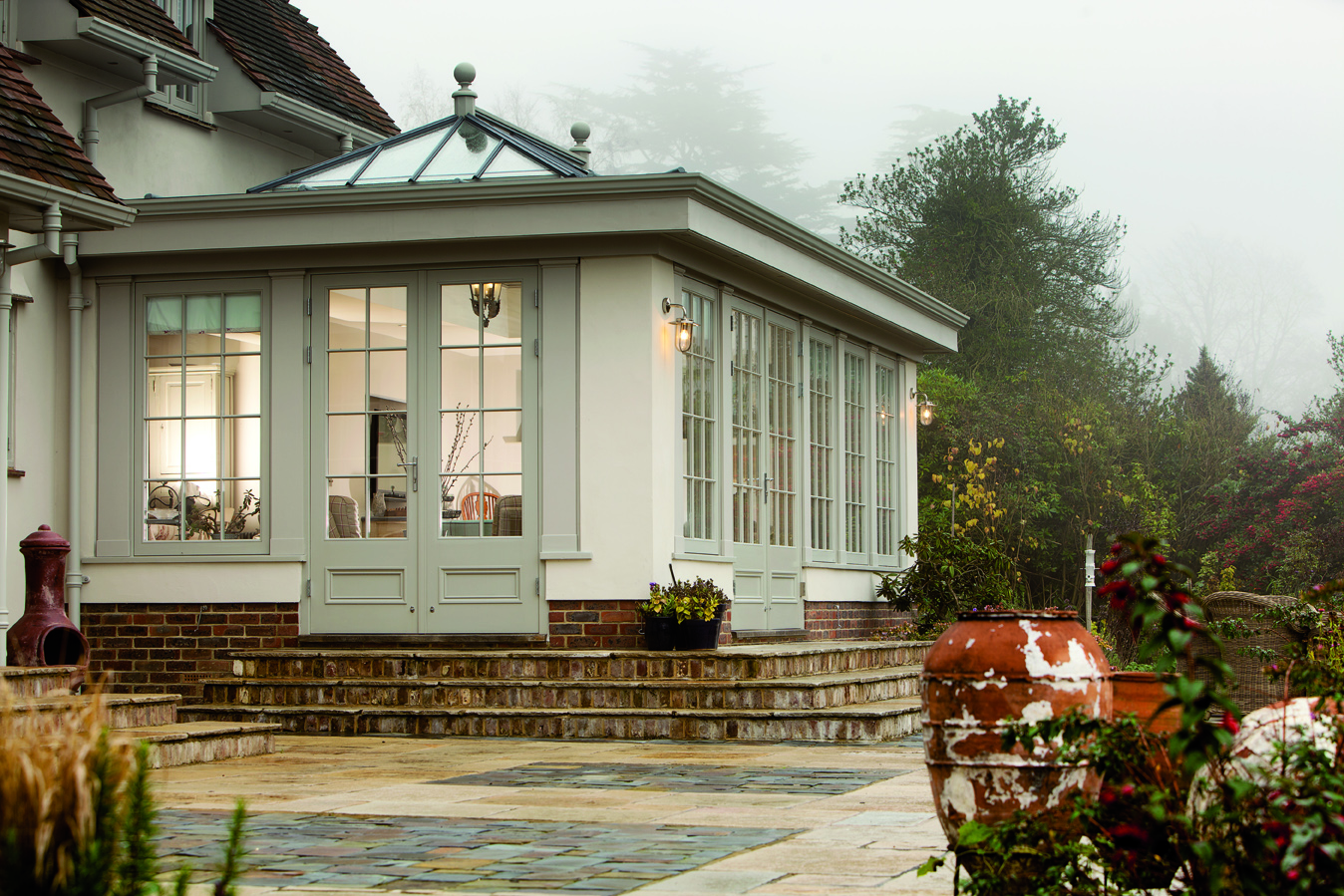
(Image credit: Westbury Garden Rooms)
Orangery design ideas that let light pour in
Orangery additions to older homes must be sympathetic to the house's period and architecture, meaning a bespoke design is always going to be the preferred option. Use these orangery ideas and tips below to get it right for your home.
1. Bring the outdoors in with an orangery full of plants
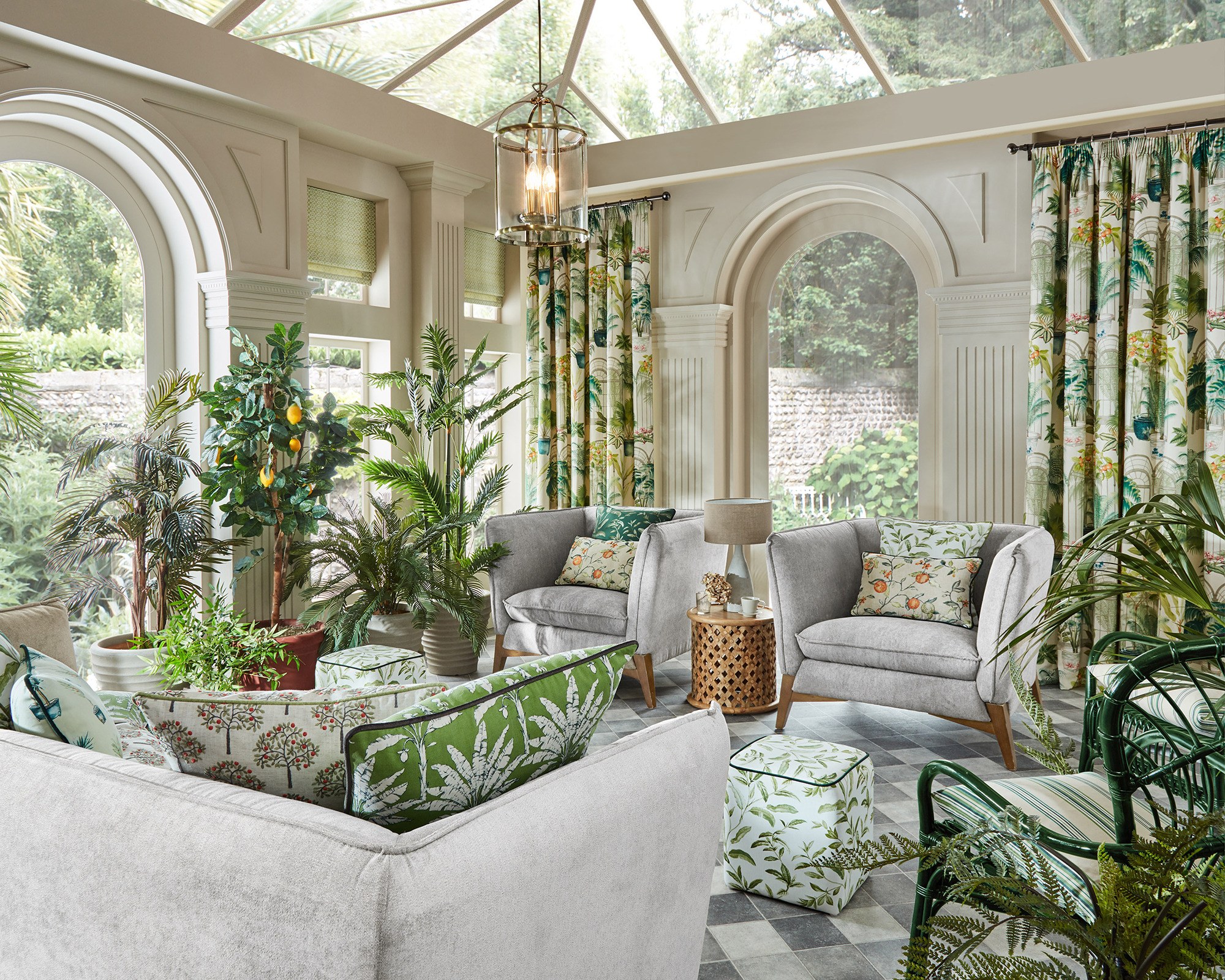
(Image credit: ILIV)
'Historically an orangery was a room on the grounds of high-end residences from the 17th to the 19th centuries where orange and other fruit trees were protected during the winter.', says Debbie Leigh, design manager, ILIV.
'Today, they are often a place to relax and enjoy a beautiful garden view. Plants work particularly well in this environment, not only from a growing point of view, but also for our wellbeing.
'Many studies have shown that plants inside the home can calm the heart rate and reduce stress, making us feel comfortable and relaxed at home.'
2. Don't like blinds? Choose a printed curtain instead
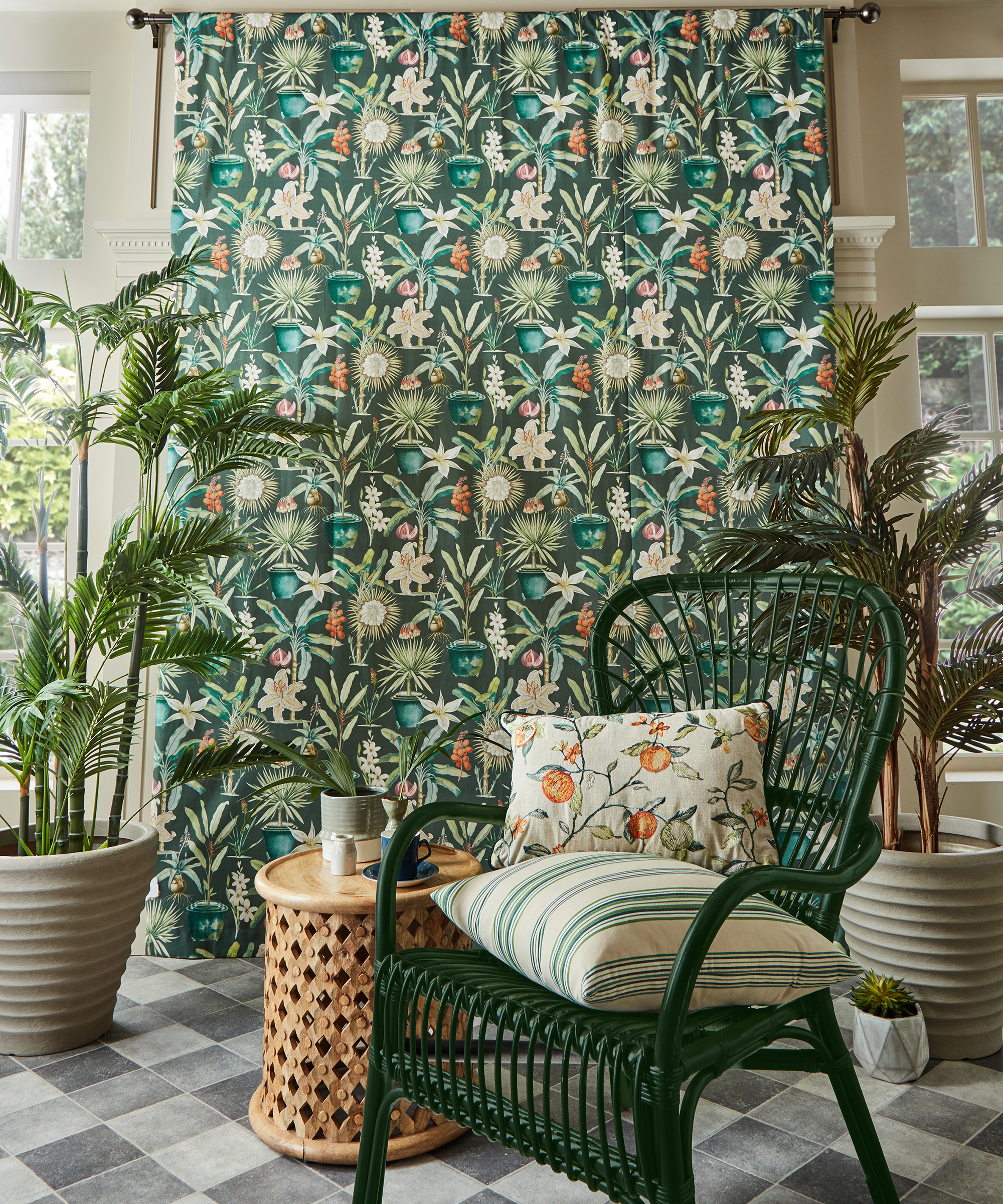
(Image credit: ILIV)
'Good quality, lined curtains are worth the investment – they are suitable all year-round offering temperature control and privacy.', says Leigh.
'Black out and thermal linings are great for orangery curtains as they help to keep the room warm in Winter but also cooler in Summer, by totally blocking out unwanted light and sunshine.
'This has the added benefit that any heating/cooling systems will work more efficiently too.'
3. Mix and match dining chairs for a rustic look and feel
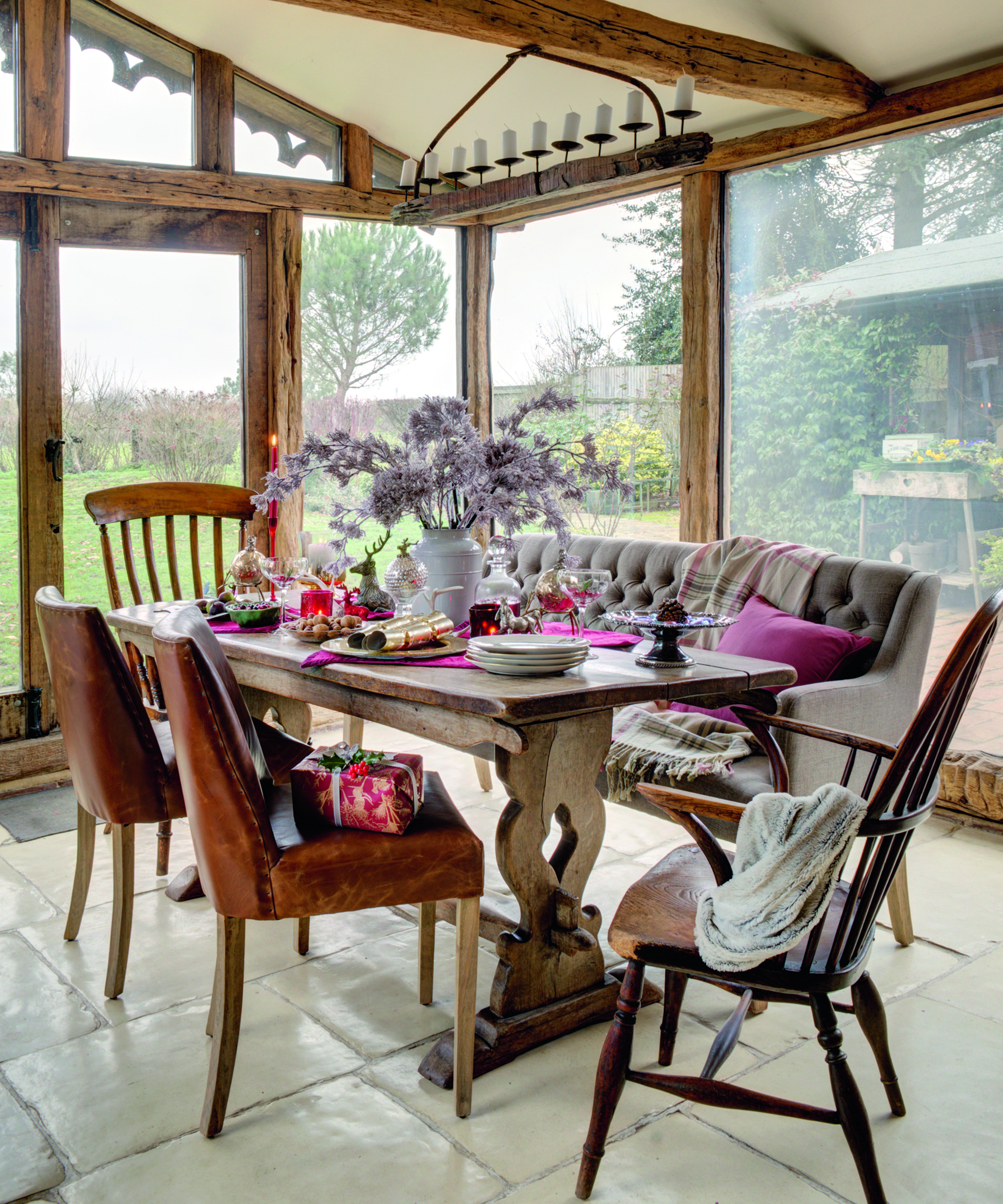
(Image credit: Future)
While coordination is key for modern orangery design ideas, a chintzy chop and change of chairs adds character and charm to this space.
If you have battered or weathered traditional dining chairs that you were looking to throw out, take them to the orangery instead.
It's an eco-friendly (and now trendy) idea that'll save you a day at the recycling center.
4. Or use the same type of chair in different colors
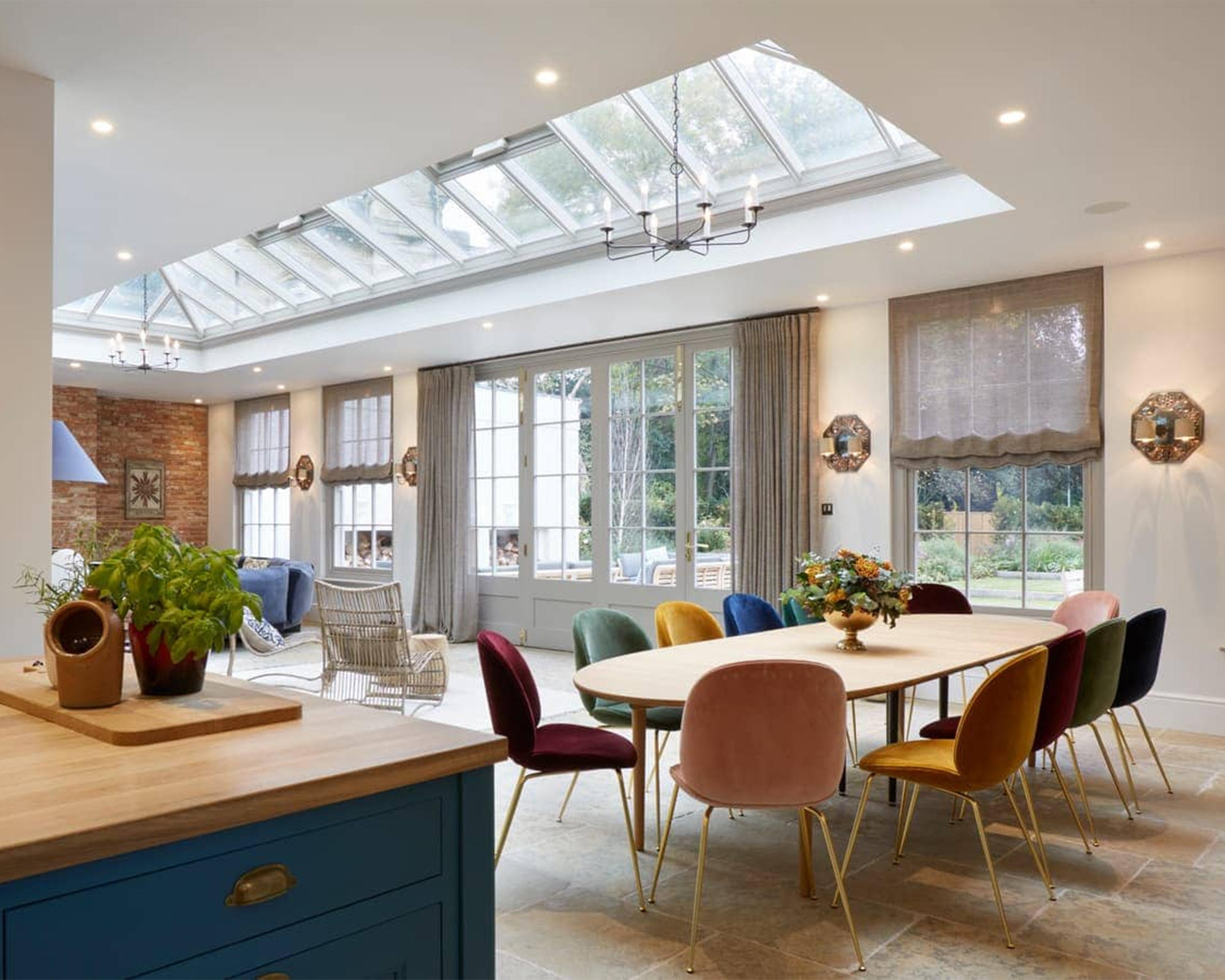
(Image credit: Westbury Garden Rooms)
If you want to create a colorful orangery design idea that's still smart and sophisticated - look for the best contemporary dining chairs, upholstered with velvet seats and gold legs.
With their smooth texture and Art Deco appeal, you can turn your sun room into a swoon-worthy speakeasy.
The chandelier-style lighting ideas add opulence to your orangery and will have you partying like it's the roaring twenties.
5. Bring the sea to you by painting your orangery blue
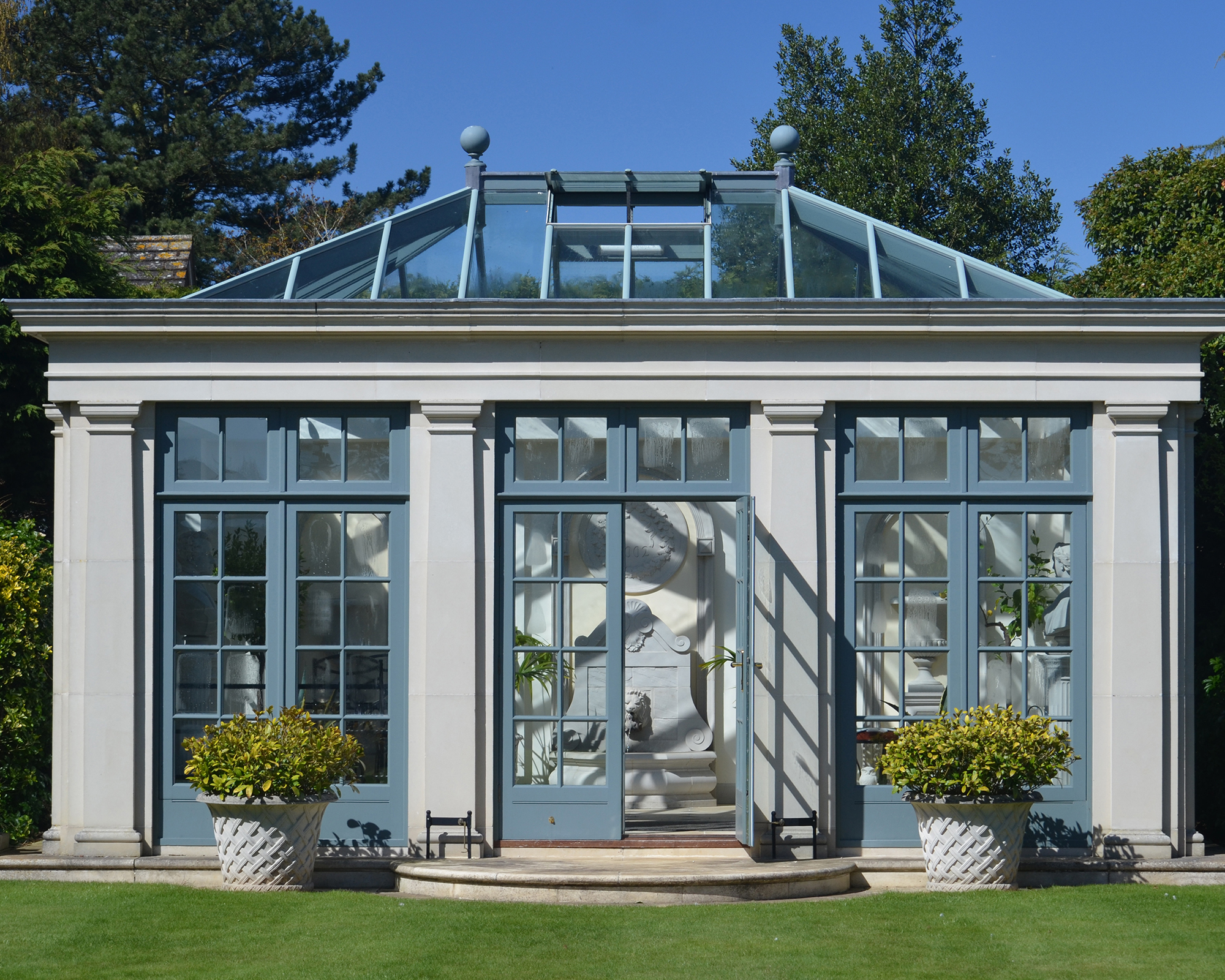
(Image credit: Haddonstone)
It's not just the interior you need to focus on when designing a glass extension design idea.
Although (generally speaking), it's the inside that counts - exterior decor needs extra special attention too.
Instead of keeping to the beige or white scheme of your orangery, blues and greys can add a contemporary coastal look and feel, while also being a calming color to look at if admiring your building from the outside.
Be sure to find a suitable exterior paint for your orangery design idea that is appropriate for wood and uPVC.
We particularly like Frenchic's al fresco inside / outside range as it is self-priming, self-sealing and self-leveling, so you only have to use one product for an even and hard-wearing finish.
6. And incorporate some coastal furnishings inside
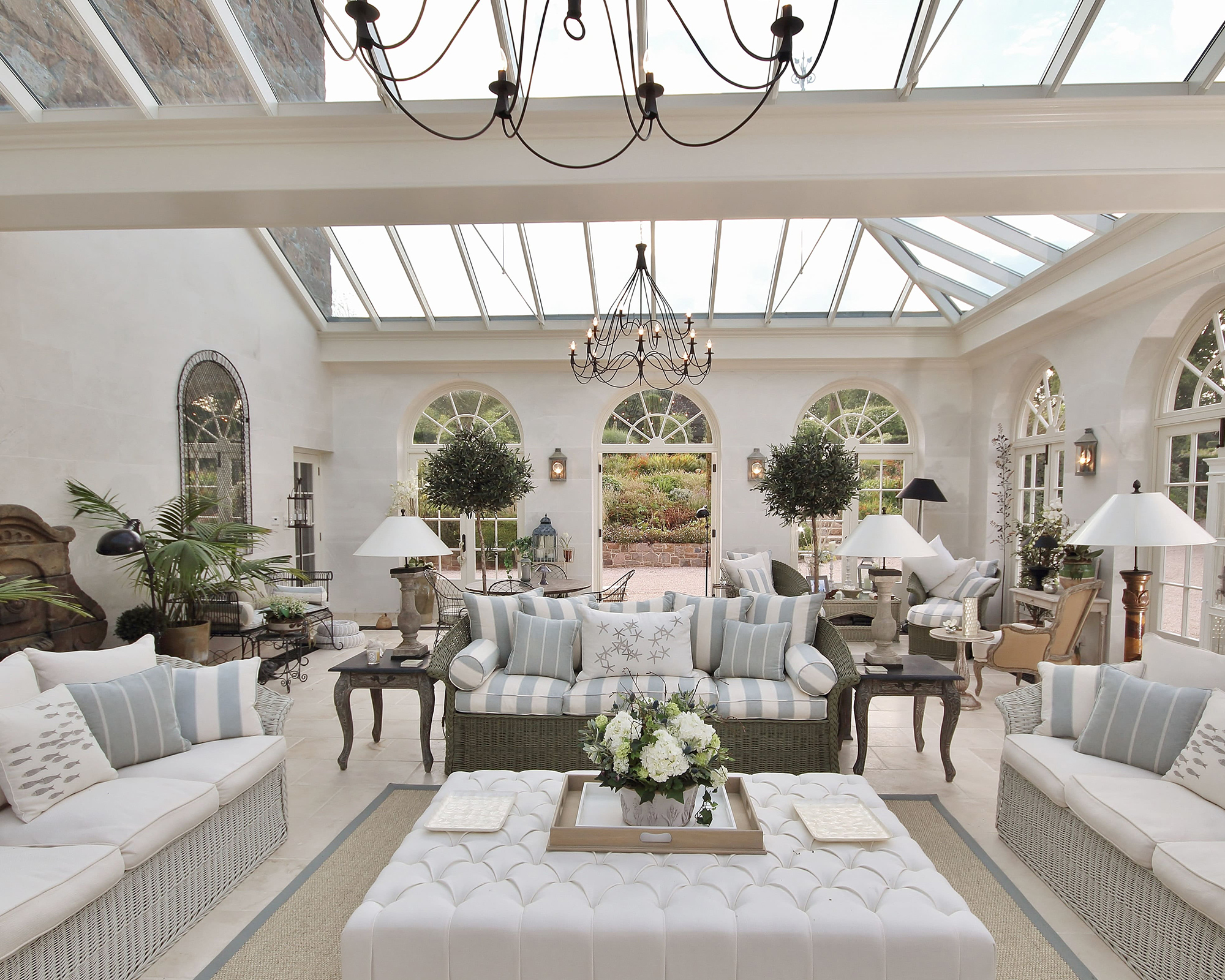
(Image credit: Hampton Conservatories)
If you want to mirror the aforementioned coastal exteriors with beach house interiors - it's easier than you think.
To create cohesion, simply look out for nautical striped fabrics for throws and upholstery, and fish-motif furnishings.
Notice there's lots of lantern lighting present too. Perfect for emulating that evening balmy beach walk after a heavy meal. The rope-like chandelier lighting idea also adds a local fishing village feel.
7. Consider custom windows (and keep them clean!)
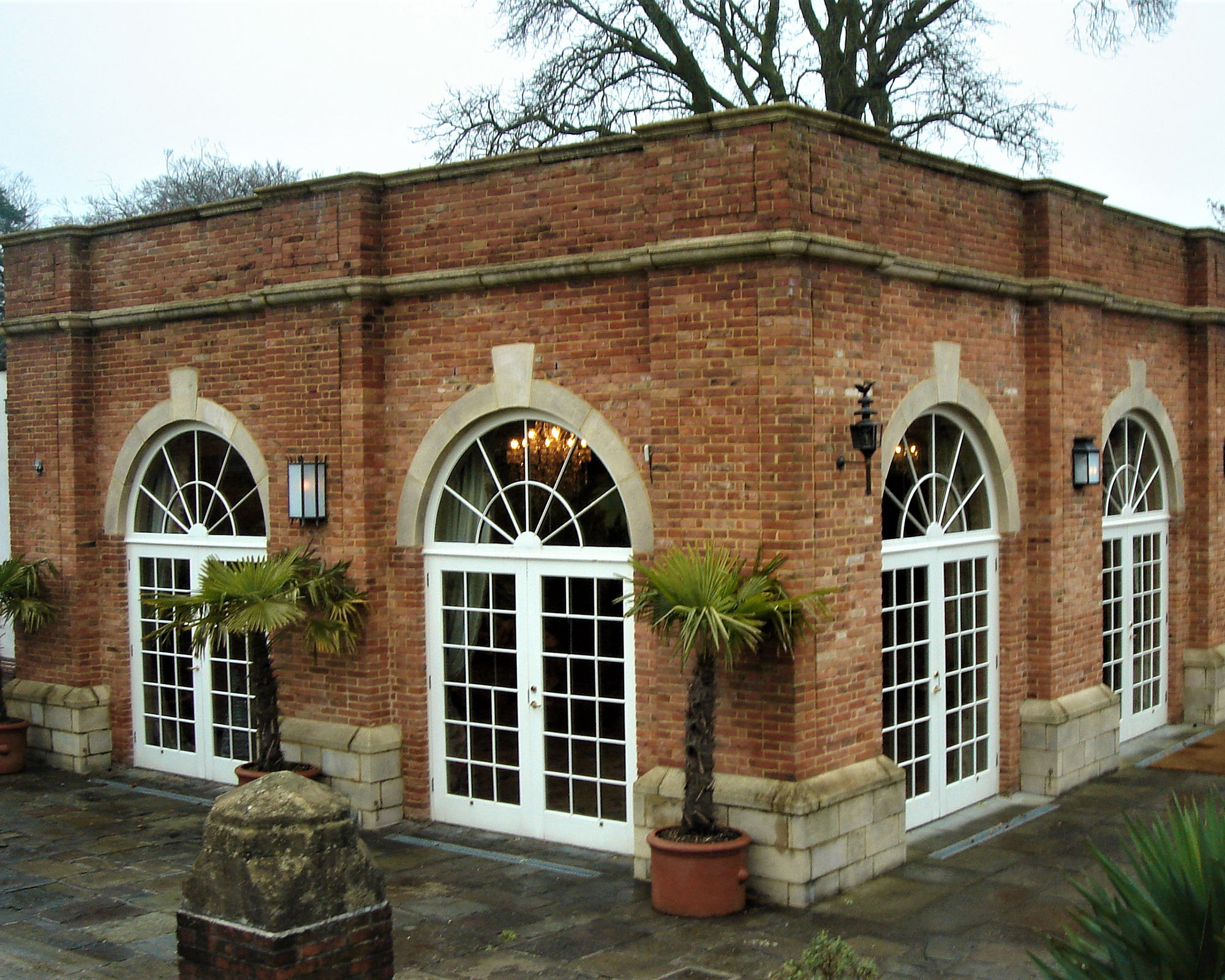
(Image credit: Redwood Stone)
When it comes to orangery design, windows aren't just a one-size-fits-all affair.
While rectangular windows tend to be the norm, arched bay windows add a sense of pretty period design to your decor, even if your build was built much more recently.
Whichever shape or design you pick, be sure to keep them in good condition with the best window cleaning solutions.
8. Use your orangery as a home office space

(Image credit: Future)
'It's clear that COVID-19 has led to many changes in our habits and lifestyles.', says James Upton, managing director at Westbury Garden Rooms.
'The most significant of which is that increasing numbers of people will be working from home and may never return to the workplace as they knew it.
'As a result, there is a greater demand for multifunctional spaces in the home, a need that can be easily met with the addition of a glazed extension.'
9. Create a central focal point with statement sofas
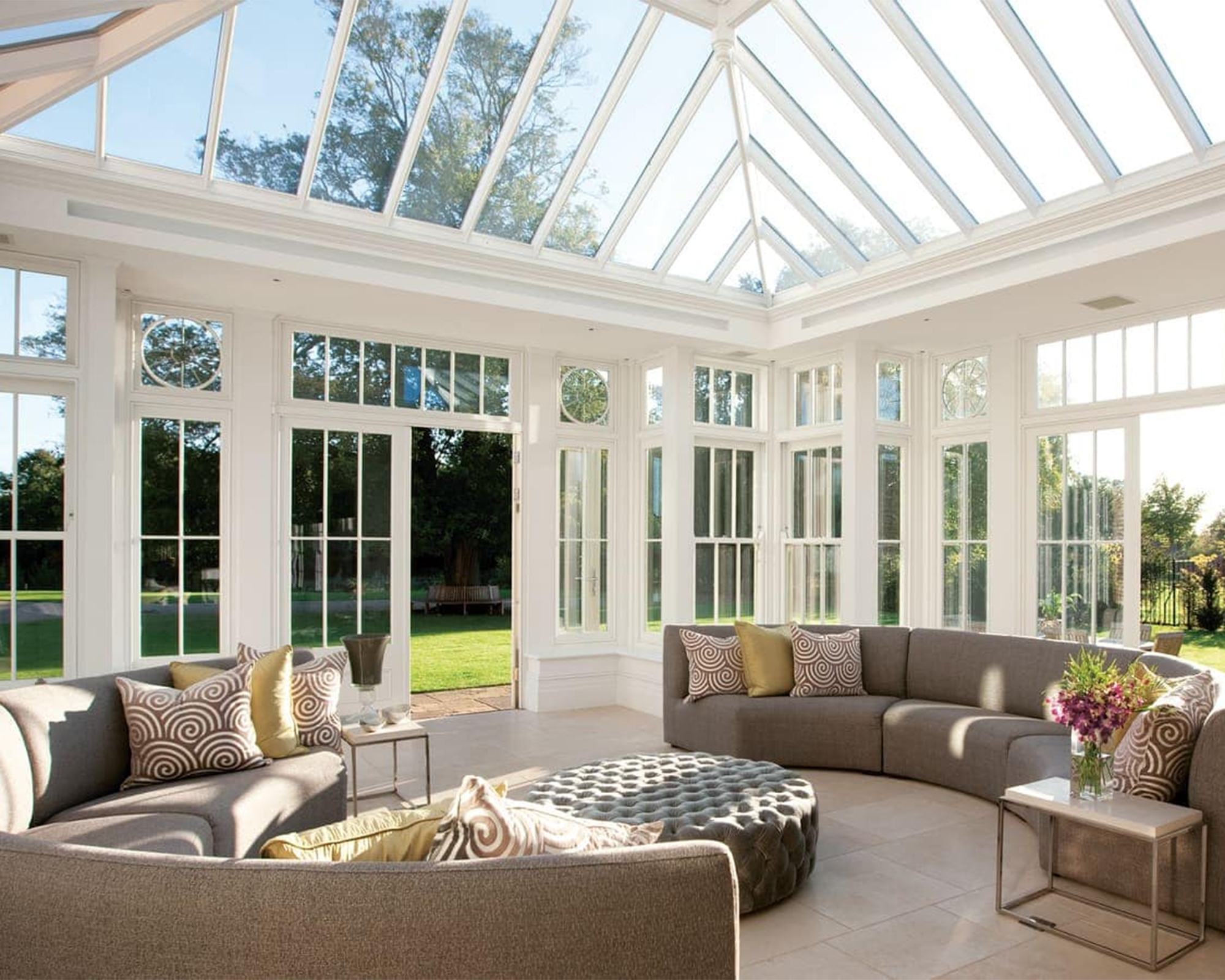
(Image credit: Westbury Garden Rooms)
Whether you're entertaining friends, or just need a cozy place to read a book, a comfortable sofa or couch is an essential orangery idea.
Positioning is also a key consideration too. Facing the garden, you risk sunlight blinding your eyes. But facing a settee away from your outdoor space can also prove to be problematic. This is because shadows may hinder your ability to enjoy activities properly.
One way to make this work is to position two sofas facing each other, as shown. This creates a social den for adults and kids alike. Choosing the best sofas for this space will symmetrically frame the room so that the space feels balanced.
Alternatively, a chaise longue draped with a faux fur throw will add luxury to an orangery design idea. This is much more easier to move, but is more suited to solo lounging.
10. Add height with a patio and stair idea
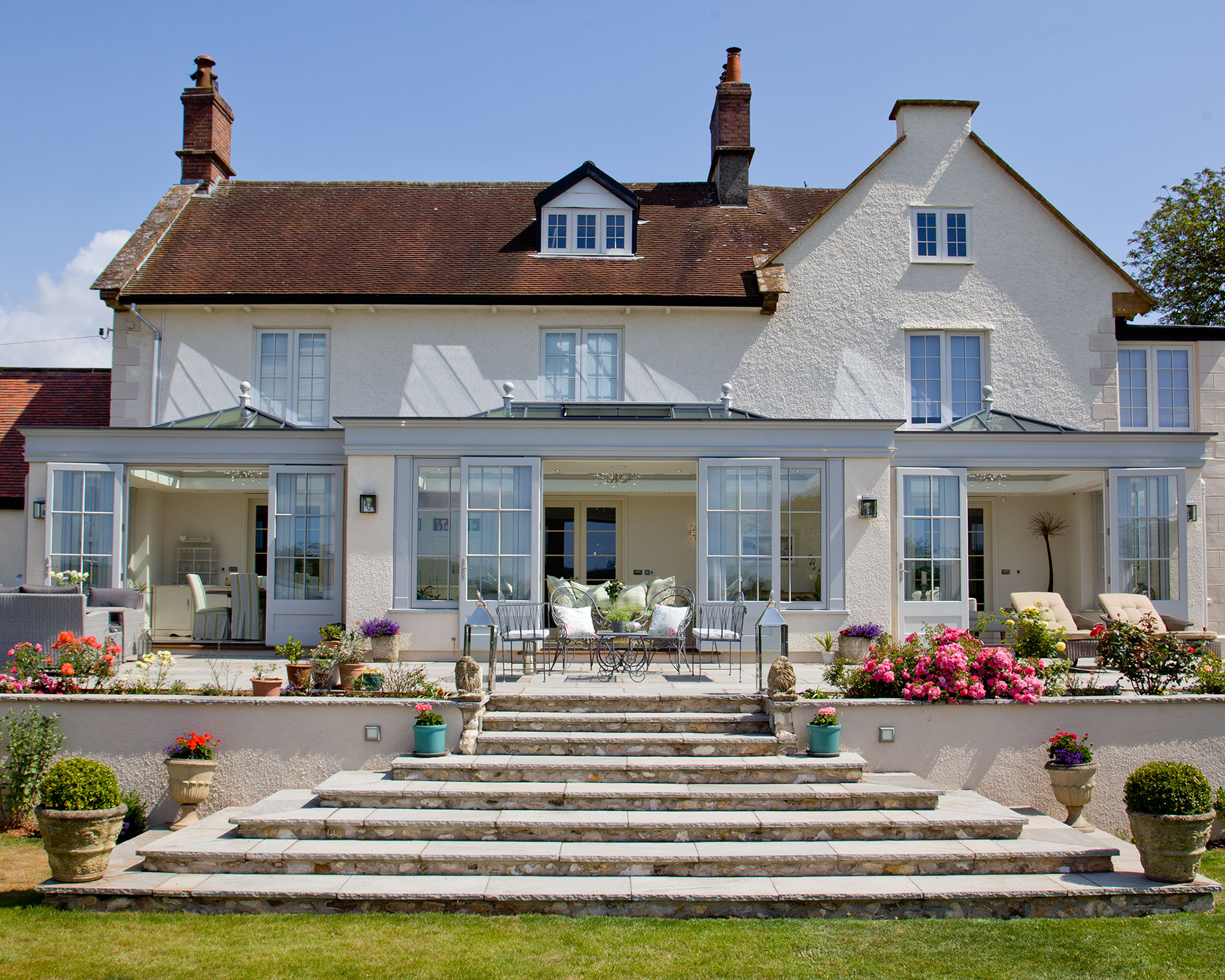
(Image credit: Westbury Garden Rooms)
If you want to literally and figuratively elevate your orangery ideas, one way to do it is to add some stairs and consider patio ideas.
Whether you have uneven foundations that need to be leveled out, or just want to add them as a decorative feature to house plants and flowers, stairs can add stability and style to your orangery design idea.
As you become older, or less-abled, a banister or patio railing can be added retrospectively into the design. This is also an inclusive idea for a young family to alleviate the risk of a child tripping on hard concrete or brick.
11. Create a Japandi scheme with rattan and light wood
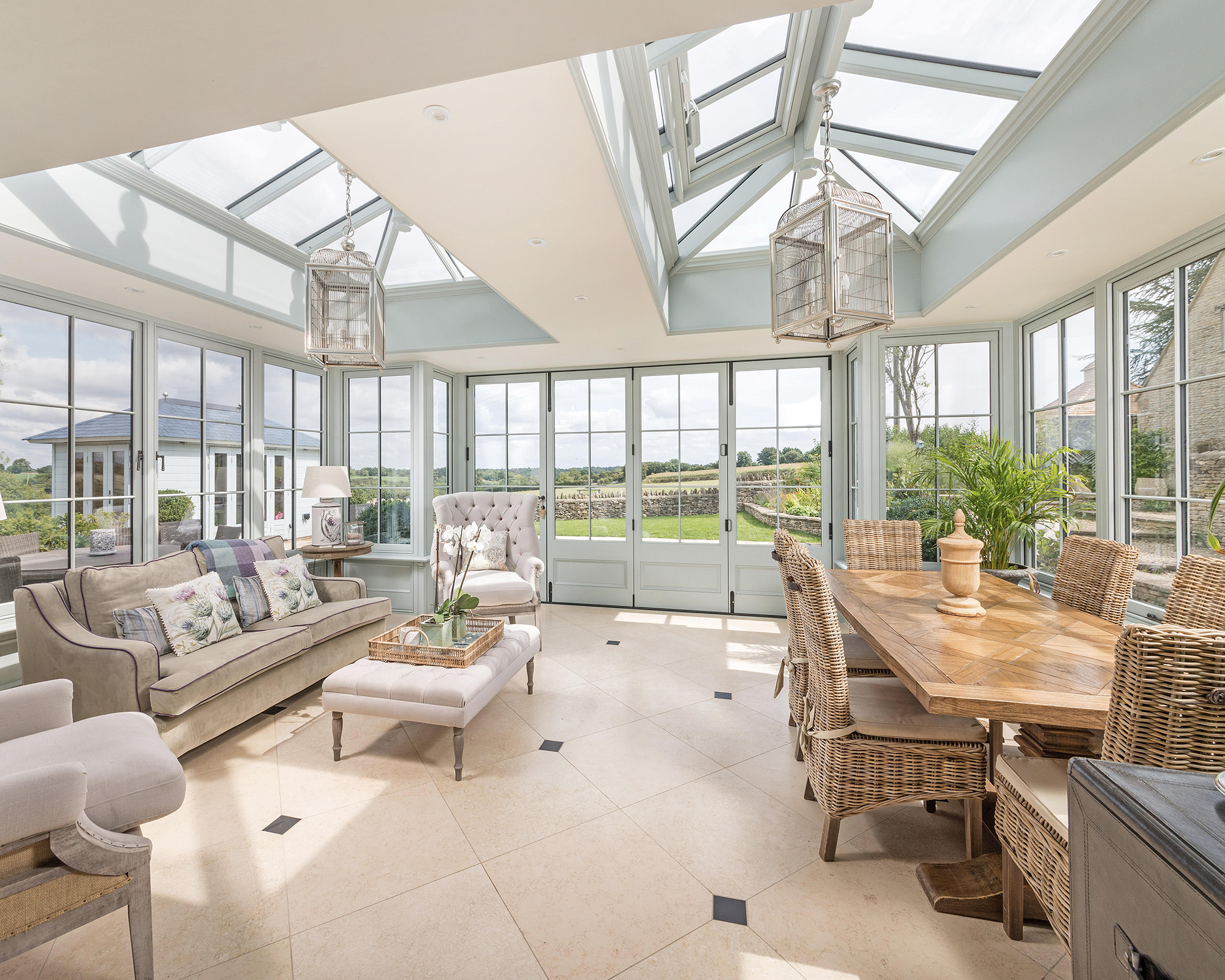
(Image credit: Hampton Conservatories)
Take advantage of a light and airy orangery by complimenting it with an interior trend that thrives on simplicity and space.
'Minimalism is key with Japandi, as is focusing on the functional nature of the space without an abundance of decor.' says Mike Manders, managing director of Lusso Stone.
'Unlike the separate design concepts, the merging of these styles ensures there is variance in texture that wouldn't be found in Japanese decor and elements of colour that wouldn't be seen in something quintessentially Scandi,'
Light flooring ideas, rattan dining sets and cream colored armchairs should all be top of mind when shopping at a furniture store to create uncluttered look.
12. Be sympathetic to your home with similar materials
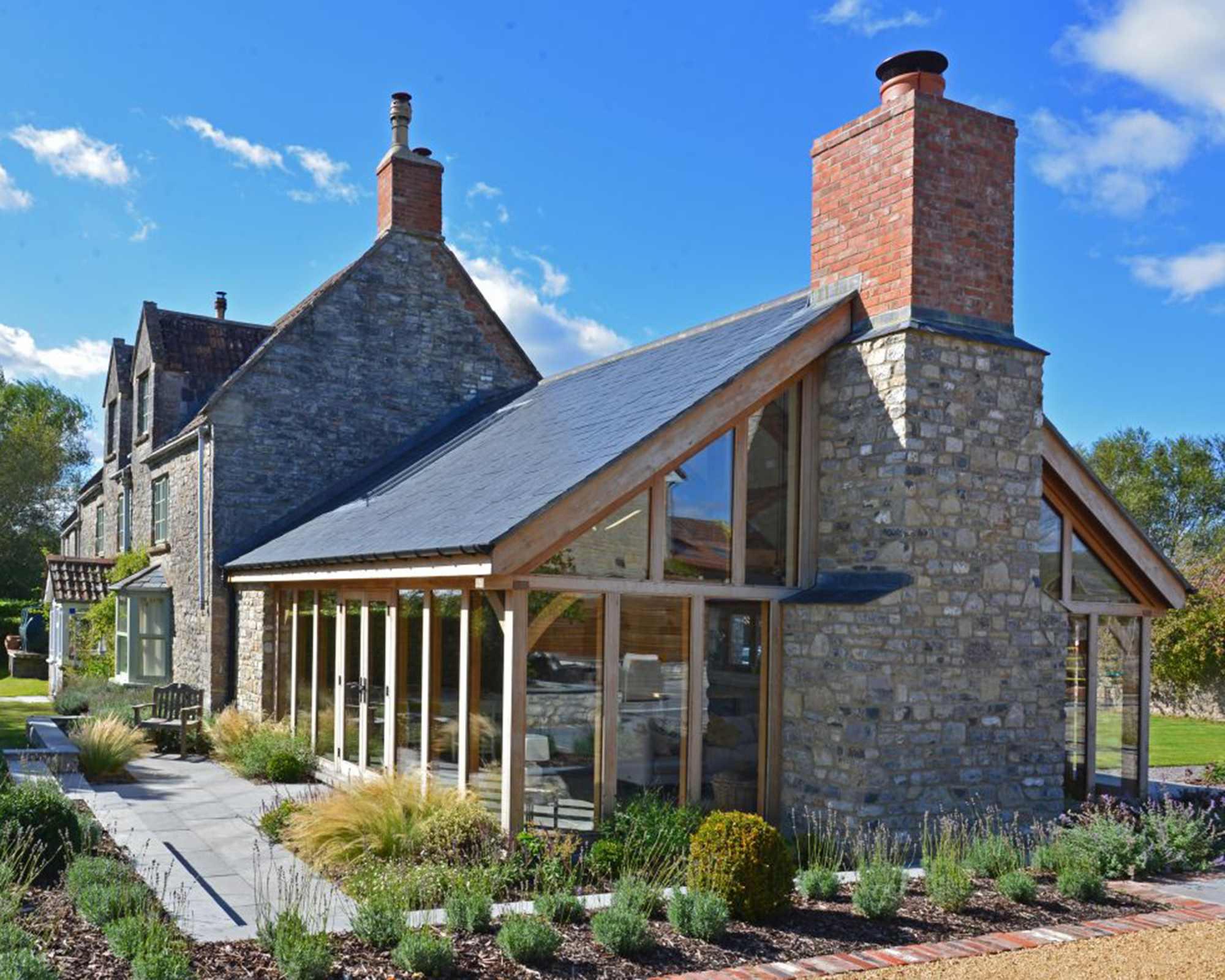
(Image credit: David Salisbury)
If you want your orangery to be a true extension of your home, and not stand out like a sore thumb, there are ways to create a harmonized aesthetic.
Even if you choose an off-the-peg design, you can get a successful finish by ensuring the design is in proportion with the existing property. Pay close attention to details, such as the roof pitch, bargeboards, finials, windows and colours.
Matching new brickwork as closely as possible to that of the original house will help your orangery blend seamlessly, will choosing window frame styles and paint finishes that complement those of your existing home.
'Where possible utilize matching building materials for the base works.', says Lisa Morton, director at Vale Garden Houses.
'Reclaim or handmade bricks, stone, flint facings and render, all need to be appropriate to the building and the area in which you reside.'
13. Build an orangery that's a year-round space
Ensure that the flow between your existing home and the new extension feels natural. This means defining the orangery's purpose early on; its use can then dictate the room's shape, proportions and size, how much solid wall space is needed – and how and where it's accessed from the original house. Ideally, floor levels from the existing building into the new orangery – or conservatory – should match, too.
Orangeries tend to be constructed with a greater proportion of wall elements and partially-glazed roofs, the advantage of these design elements being that it is easier to place furnishings, such as kitchen cabinets, within the orangery itself.
14. Choose the best doors for your orangery

(Image credit: Evolution Windows)
Perhaps the main attraction of an orangery is the connection it creates with the garden. Most period-style additions will open out to the garden through French doors, but bi-fold doors are popular for more contemporary orangeries as they can stack to the side to allow for a wider opening.
Consider whether the conservatory will step down to the garden or be on a more level threshold, with direct access to decking or a patio area. If the latter, mirror the flooring inside and out for a greater flow.
15. Make the most of light and garden

Apropos contemporary orangery , with aluminium framed windows and a clear indoor/outdoor link. A similar structure would cost £32,000
Maximising daylight and views over the garden is also vital, so whether you're planning a contemporary or traditional-style orangery, consider slim sightlines for the majority of your glazing.
For traditional-style orangeries, French doors – perhaps on more than one side of the room – will fit stylistically; for more contemporary structures, consider folding doors that will open the room right out to the garden.
In both cases, flush thresholds will make the transition from the house to the garden seamless, helping you create the perfect indoor outdoor room.
16. Get orangery heating right
Using the space all year round will really only be an option with the right glazing and a ventilation and heating system that makes the room comfortable.
Just as with conservatories, solar-control coatings will reduce heat build-up, while low emissivity glass, and double- or triple-glazing will keep the room snug in colder weather.
For heating the space in colder months, underfloor heating is usually the best option as it takes up no wall space. Trench heating, a warm-water system sunk into the ground with a grille on top and running around the perimeter of the room, is another possibility. A wood-burning stove can be a stylish focal point in a glazed extension.
17. Ventilate your orangery

Orangery by Westbury Garden Rooms ; prices start at around £40,000
(Image credit: Westbury Garden Rooms)
For ventilation, consider incorporating panels into the roof lantern that can be opened as part of your orangery design – solar or automatic controls are more practical than manual ones. Automatically-controlled vents can also include rain sensors.
Other solutions include mechanical fans mounted within the roof pinnacle, passive trickle vents within the roof ridge or opening windows within the vertical side frames of a roof lantern.
18. Link indoor and outdoor spaces
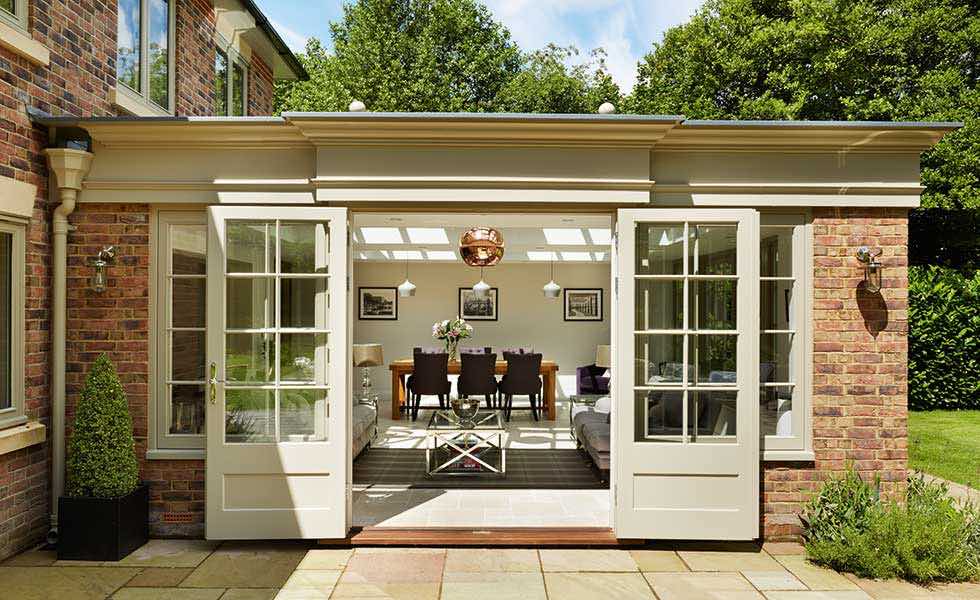
This traditional style orangery has been added to a new build property by owners who were keen to add some more character to their home. A similar project would cost £70,000 from Westbury garden rooms
Unite the space to your garden with clever landscaping and lighting. Planting around the building can soften its edges from outside. As for outdoor lighting, 'Illuminate something beyond the room itself – such as the garden – as this takes one's eye out beyond the glass. Ideally, light some planting close to the glazing and then something beyond,' advises Sally Storey, creative director at John Cullen Lighting.
'To get the most out of lighting the garden, it is important that the conservatory lighting is lit to a lower level to minimise reflections. Another simple tip is to put the interior lighting on a dimmer switch to ensure that you can change the mood to suit the occasion.'
19. Don't overfurnish your orangery
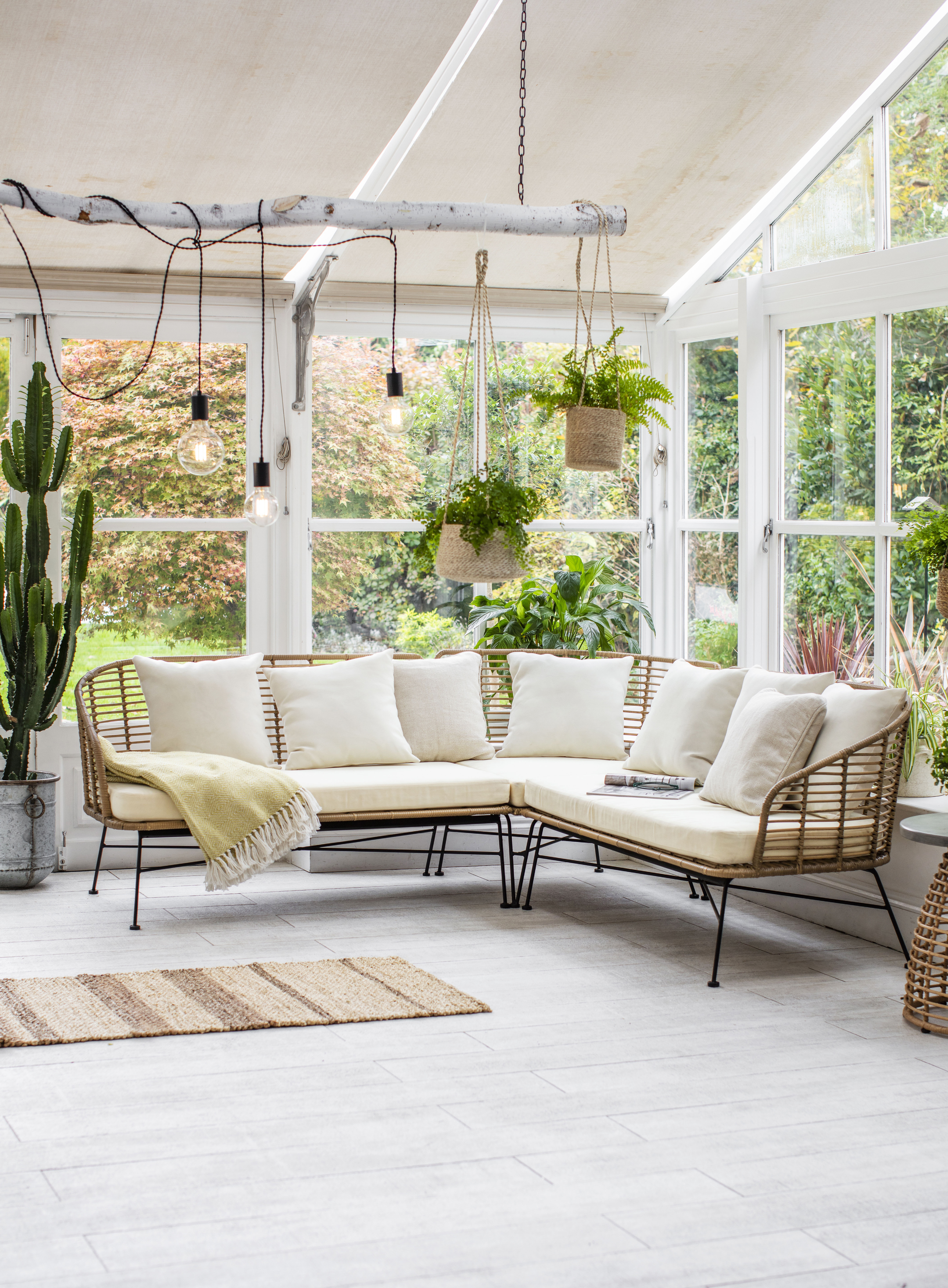
Hampstead sofa , Garden Trading
(Image credit: Garden Trading)
Orangeries are typically light, airy, and delicate, so require furniture that won't overwhelm them. A lightweight rattan set with cream cushions is the classic choice for an orangery, as is elegant wooden furniture, vintage or modern, depending on the exact style of your orangery. If you're aiming for more of an indoor/outdoor look and have continuous flooring between the indoors and outdoors, you could even go for a delicate wrought iron garden set.
What is the difference between an orangery and a conservatory?
Orangeries have one important characteristic that sets them apart from conservatories or glass extensions: they have glass roofs, but the walls are more solid, at least 50 per cent brick or column. This makes orangeries look and feel more like natural extensions of an existing home rather than an addition.
'The main technical difference relates to how the roof of each extension is constructed.', says Karen Bell, creative director at David Salisbury.
'A very simple differentiation is that a conservatory has the majority of its roof glazed, whereas an orangery tends to have a solid perimeter roof with roof lanterns to allow light in.'
'To apply some numbers to this, if there is more than 75% glass in the roof, it is a conservatory; less than 75% tends to be classed as an orangery.'
'Typical characteristics of a conservatory are that they are majority constructed of glass, usually have a dwarf wall around their perimeter and have a fully glazed roof. '
'In contrast, the hallmark of an orangery is a perimeter flat roof area with one or more lantern roofs. This often works well where a larger extension is required and height is limited. '
'They are particularly suited to being designed as kitchen extensions, as the roof can incorporate insulation, extraction, air conditioning, AV and so on – all of the features required for today's modern living.'
David Handley, Commercial Director at Prime Oak adds: 'The key feature of an orangery is the roof lantern and like conservatories they allow bountiful natural light into the space by day and offer a star gazing platform by night.'
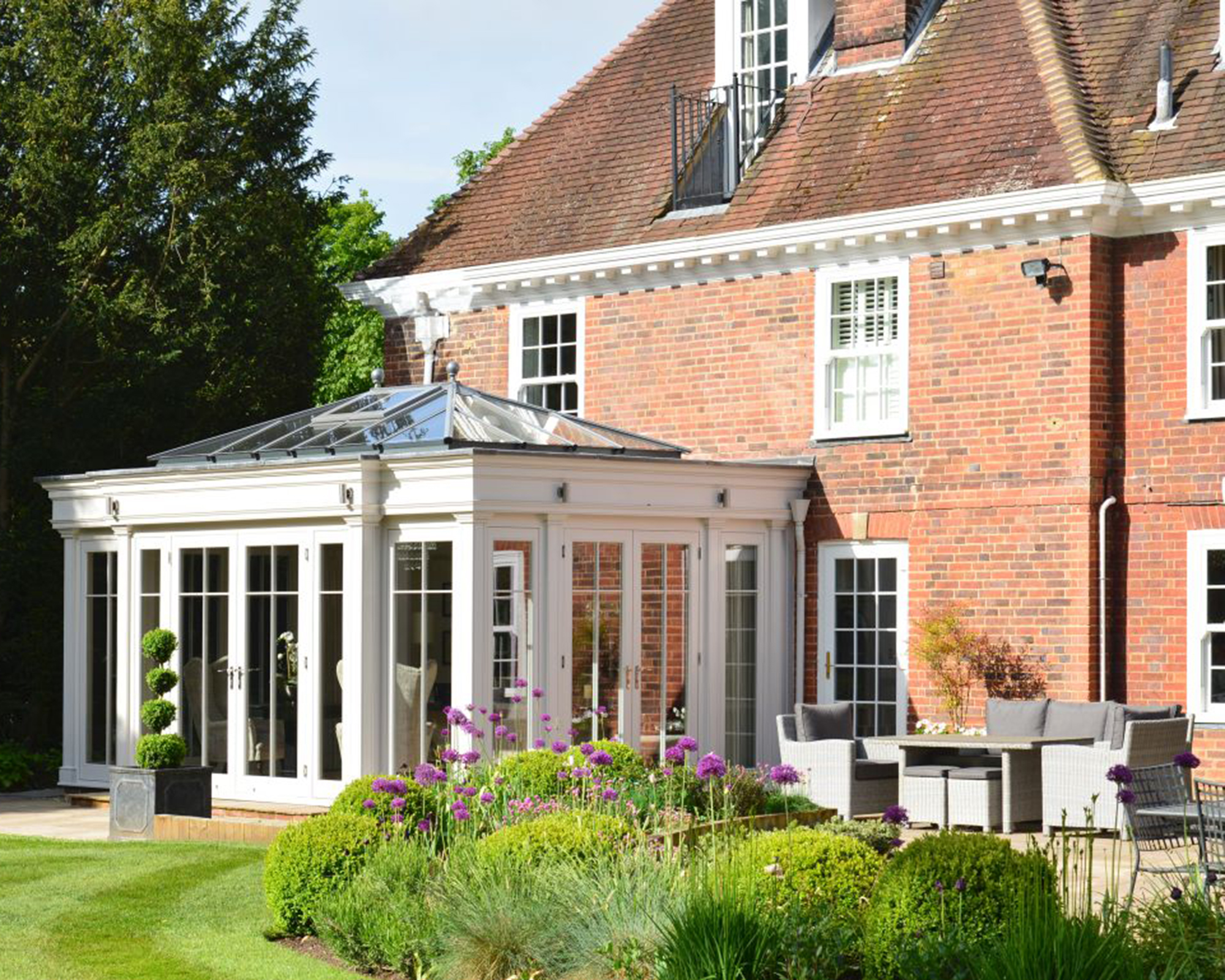
(Image credit: David Salisbury)
Can an orangery be used all year round?
'A glazed extension, such as an orangery, is a striking addition to any home but homeowners should consider the practical use of the space before going ahead.' says James Upton, managing director of Westbury Garden Rooms.
'A good designer will work with the family to understand their needs and create a new room that works for everyone whether that be cooking, entertaining, working, simply relaxing or all of the above.'
While David Handley, commercial director at Prime Oak adds: 'Orangeries also provide the perfect balance between light and shade preventing the room from becoming too hot or too cool.'
'The temperature is easily moderated throughout the summer with a ventilated lantern, allowing a gentle through breeze when required.'
'In the winter our clients like to opt for underfloor heating or a log burner adding a cozy ambiance to the room. Due to the insulated roof, an orangery maintains a comfortable temperature all year round.'
And Mervyn Montgomery, managing director and founder of Hampton Conservatories comments: 'One of the main benefits of the addition of a glazed extension such as an orangery is the fact that it helps to blur the lines between your home and garden.'
'The incorporation of large vertical panes of glass flood the room with light and give you uninterrupted views of your garden you can enjoy all year round, no matter the weather.'
'A well designed orangery will be comfortable in every season, never feeling too hot or too cold. By incorporating elements such as rain sensors, temperate control technology and solar reflective glass the room adapts to the outside temperature.'
'Often homeowners are looking to create a seamless transition between their home and garden, and the addition of an orangery is the perfect way to do that.'
'An orangery helps you embrace your garden in every season, and by inviting the outside in, you can truly connect with nature.'
What are the benefits of an orangery?
Typically more substantial in its proportions than a conservatory, with, at the very least, a partially solid roof with more brickwork and full-height brick pillars, an orangery extension will still give you wonderful views over your garden.
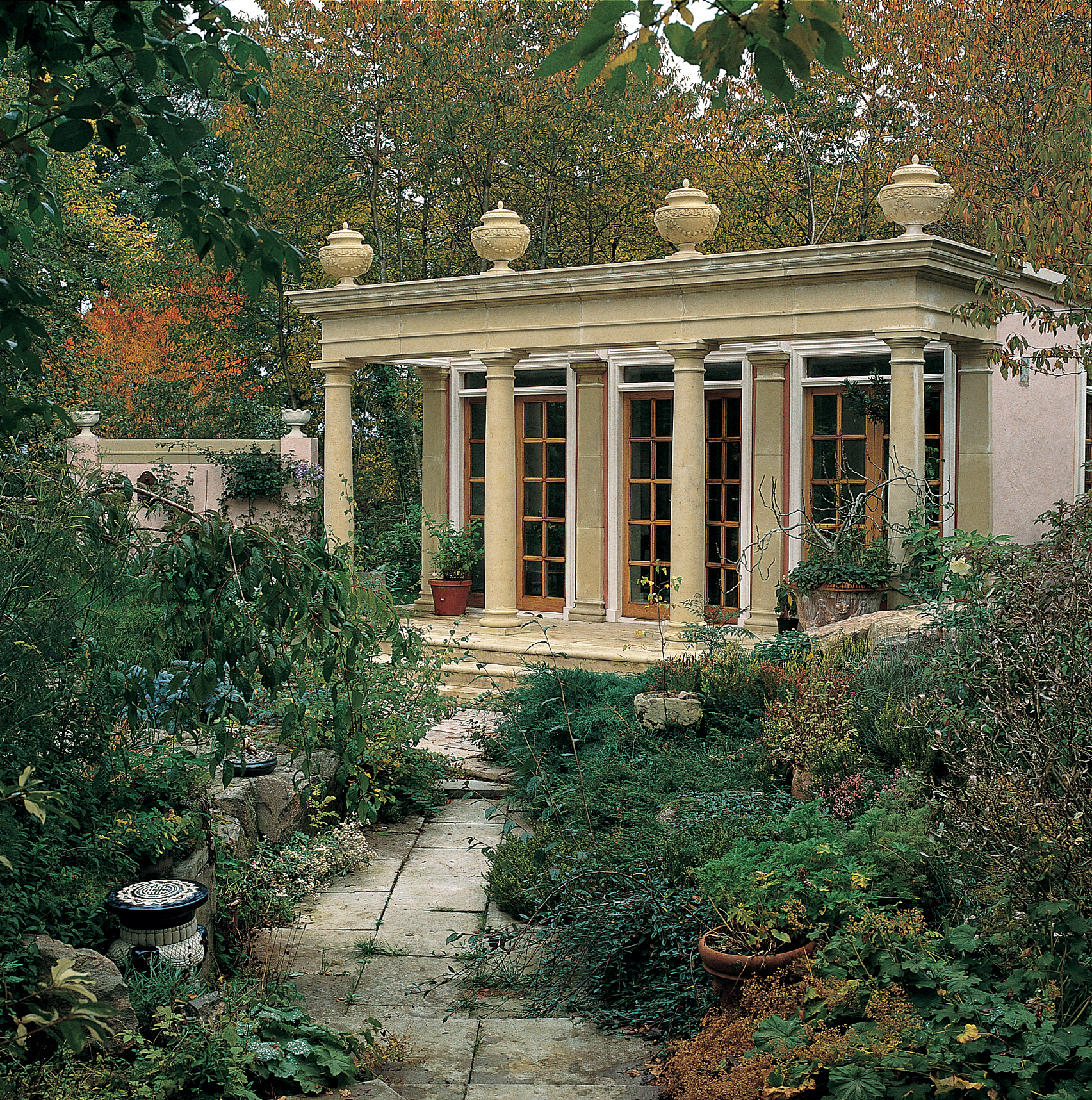
(Image credit: Haddonstone)
Classic orangeries will be complete with brick piers, a centralised glass roof pitch, traditional cornice, internal pelmet for insulation and will more likely be made bespoke, if for a period property.
Modern orangeries will see more decorative cornice and roof structure, modern insulation or heating and will be finished with more slender frames, and other contemporary finishes such as wide sliding doors.
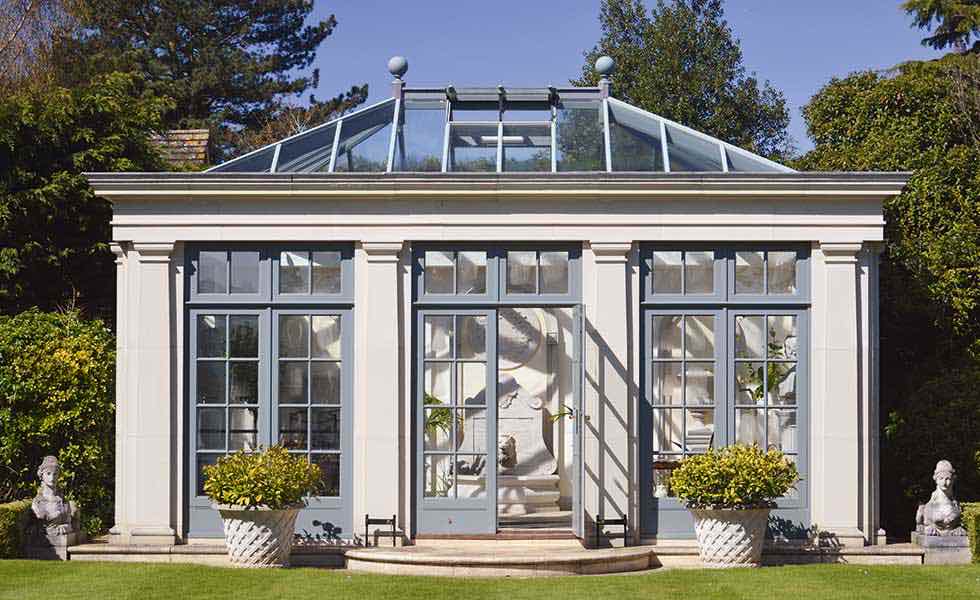
This Haddonstone orangery has a modern finish, but a traditional design. Costing from around £120,000 it is at the luxury end of the spectrum
How much will an orangery cost?
On that note, how much an orangery costs depends on your desired outcome. Orangery costs depend on the complexity of the design and materials used but, as a general rule, conservatories cost from £10,000 upwards, while the average orangery cost starts around £20,000. It's worth noting that you can find orangeries that cost around £10,000 but the materials used may be more basic.
Expect to pay an average of £40,000 for an orangery. This is because the construction work is more substantial than that of a conservatory and the labour required to complete an orangery design is similar to that required of a single storey extension. As with any home improvement project, you could spend even more than this depending on the size, materials used and the complexity of the design.
For a particularly large orangery, something high-spec, or an orangery with a kitchen or bathroom, you could pay upwards of £70,000
Will an orangery add value to my property?
Orangeries can add value by boosting your home's kerb appeal and improving both your family life and your home's saleability. But choose your materials carefully.
'The addition of an orangery extension is a proven way to add value to a property. A bespoke timber orangery extends the existing living area of a property, creating communal space that meet the changing needs of families.', says Mervyn Montgomery, managing director and founder of Hampton Conservatories.
'Furthermore, the addition of an orangery will transform unused areas of your garden into an airy living space suitable for everyone.'
'By opting for high quality materials and working with a trusted manufacturer you can be safe in the fact that an orangery extension will increase the value of your property.'
'Although there are no guarantees when it comes to selling a property, an extension with classical proportions and built from premium timber is likely to maintain its value much more than a lower quality, uPVC version.'
How to plan an orangery
It might be that you hire a specialist orangery company, who can help you with all the planning aspects of the job – or that the architect or builder is able to advise. However, it's always worth knowing the basics to ensure your project is progressing along the right lines. Use these planning know-how tips below to get it right.
For more practical information, design and planning tips, see our essential guide to extending a house.
Does an orangery need planning permission?
Planning permission is not usually required for an orangery, and can be considered as permitted development provided:
- They cover no more than half the area of land around the original house;
- Are no higher than the highest part of the roof;
- Don't extend beyond the rear wall of the original house by more than four metres for an attached house or six for a detached.
'If you are extending on the rear or side of your property, it is possible that this would fall within Permitted Development (PD) which would mean that planning approval would not be required.', says Karen Bell, creative director at David Salisbury
'A basic guide is that you would need to limit the depth of the orangery to 4 metres (detached property) or 3 metres (linked property) and no more than 4 metres in overall height. A side extension can be no more than half the width of the property.'
'If you live in a listed property then choosing a supplier that has a wealth of experience of working on listed buildings and engaging in dialogue with the conservation officer at the design stage will make the planning process run smoothly.'
'It is essential to consider the character of your property and choose a design that will either complement the architecture or be a complete contrast, i.e. by adding a contemporary design so the distinction between the old and the new is evident.'
Does an orangery need to comply with building regulations?
Part L1B of building regulations states a limit to the total glazing in a property to 25 per cent of the floor area. However, if you can demonstrate compliance with thermal requirements using any amount of glazing, the building will be regulations compliant. A structure that is closed off from the rest of the house with external grade doors is exempt from building regulations in most circumstances.
To be on the safe side, always involve the building control department in your plans early on. A professional orangery specialist can help you with this.
What if you live in a Conservation Area or listed building?
Within designated areas – including conservation areas – you may need to apply for planning permission for your orangery even though you wouldn't have this obligation elsewhere. Local authorities can also remove some permitted development rights with Article 4 directions.
If your home is listed you will need to apply for listed building consent.
If planning permission is needed, it is more likely to be granted on structures at the rear of a house. Many planners are now particularly receptive to contemporary frameless additions that offer a distinct separation between old and new.
As with all additions, success relies on a sympathetic reflection of the main property, in terms of scale, architecture and proportion.
For more information, visit the Planning Portal and contact your local authority to check the specific details of your project before you start work.
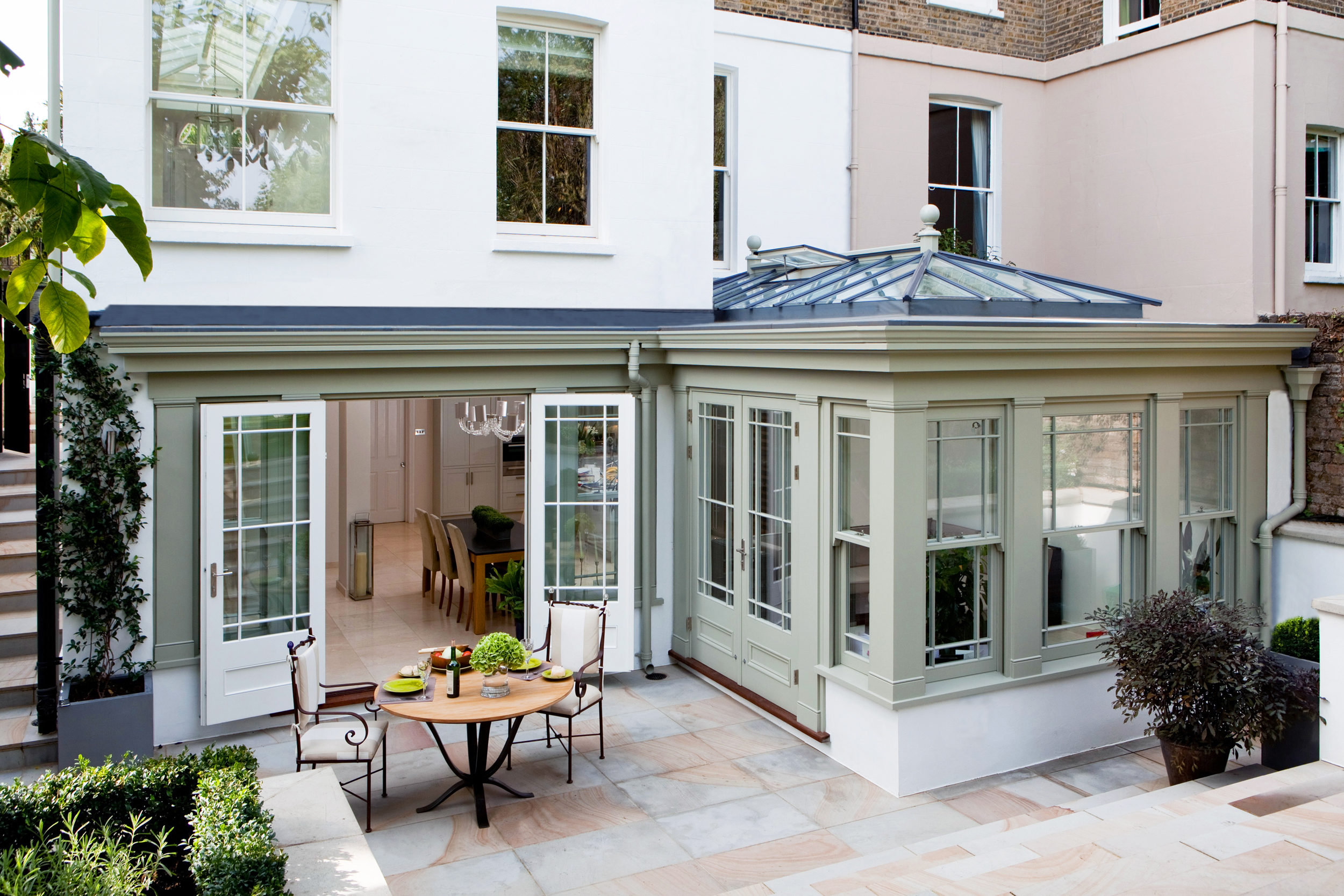
Orangery by Westbury Garden Rooms ; prices start at around £40,000
(Image credit: Westbury Garden Rooms)
Choosing the right framing for your orangery
The latest frame solutions for orangery doors and windows include much narrower timber, aluminium, composite and uPVC frames, which allow for more glass and better views of the outside, and can include bi-fold or sliding styles. But which material is best?
- uPVC: A commonly used material for conservatories, PVCu is more affordable than the alternatives, widely available and maintenance free. However, it is not the best choice to complement a period home as the material tends to result in bulkier, inauthentic sections and details.
- Aluminium: Traditional glass houses had metal frames, and aluminium is still a popular choice for its classic looks and slim sightlines. It can also be used to cast more ornate designs, similar to the orangeries of the Georgian and Victorian eras.
Modern aluminium frames include thermal breaks to avoid heat loss, and can be powder-coated in any colour to produce a maintenance-free addition.
- Timber frame: Timber frame is the alternative desirable option for a period home. Oak-framed orangeries look stunning
and if unpainted the wood will weather beautifully. Other popular timbers include Douglas fir, sapele and Accoya, which is modified to be incredibly durable and resistant to fungal attacks.
Ensure that wood is factory painted or treated, which will make it rot resistant and mean it should last around 10 years before requiring any maintenance.
- Composite: For the best of both worlds, some manufacturers offer composite orangery frames, which have an aluminium exterior, great for low maintenance, and a timber interior, for warmth.
IQ Glass' Carminati Skyline lift-and-slide doors have a super-slim 37mm vertical frame, the world's slimmest timber doors. Available in fir or oak with a laminated timber structure for additional strength, beauty and performance, these doors can come as double- or triple-glazed.
The patented base track is designed to be flush inside to outside, with a unique sliding track cover for when the doors are open. This creates a flush internal to external base detail with no track indents. This also means the sliding tracks and wheels are never fully exposed, providing a long life expectancy.
These lift and slide doors have extremely high levels of thermal insulation due to the timber, with Uf values as little as 1.2 W/m2k.
Picking glazing options for an orangery
The main component of any successful orangery is the glazing, which must perform an almost impossible task, blocking excess solar gain, while retaining heat on colder days. There are many options when it comes to glass, and choosing well – particularly for the roof – will ensure the temperature of your space is comfortable year round.
Low-e glass with an argon-filled cavity is a good option – it has a thin low-emissivity coating to reflect heat, while the gas in the cavity greatly reduces the transfer of heat.
Other types of glass have coatings to reduce the sun's rays and stop the orangery overheating; try Roof Maker's, which also retains heat in winter. Pilkington has several options, including Cervoglass, an insulated glazing product that protects against both temperature extremes.
Another option for orangeries is self-cleaning glass, which helps gather dirt so that it simply washes away when it rains.
Bear in mind that when glass is treated it can lose some of its clarity and take on a slight tint, so take a close look at the options available and choose one that's as clear as possible. For the greatest clarity and maximum light, look at low-iron glass.
With so much glazing, security could be an issue, but glass in orangeries should be toughened up to a height of 800mm, or up to 1,500mm for glass doors. Any quality glass roof should also feature toughened glass as standard.
5. Employ an architect
If your orangery is part of bigger renovation project, a conversion, or self-build, it is advisable to find an architect that has some experience designing properties that incorporate orangeries in your area. They should be able to advise on what the local planning office is likely to allow and help with any planning applications.
Orangery Dining Room Extension
Source: https://www.realhomes.com/design/how-to-add-an-orangery



0 Komentar